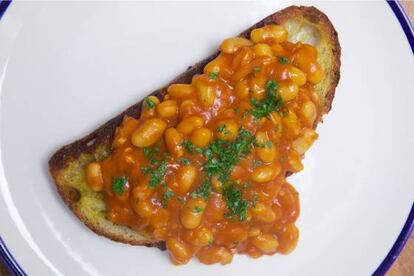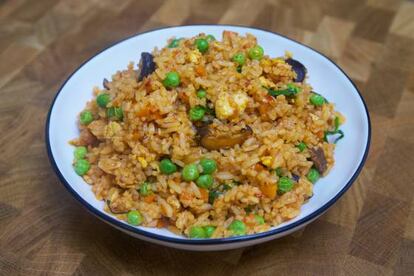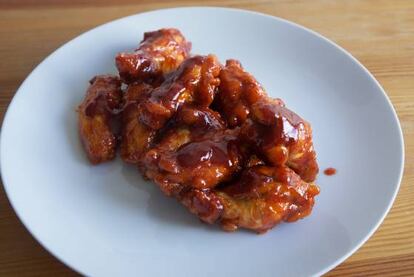Ode to ketchup: Five uses beyond the hamburger topping
The most popular condiment in the world can be used as a main or secondary flavor, as a glaze, as seasoning and as a base to create new and different sauces


The time has come to redeem an ingredient with an undeserved reputation; to show the world that there is a place for it beyond the fast food joint packets and the children’s menu at Denny’s. Ketchup is one of the great condiments of the world, with the potential to be used every day and in the most sophisticated dishes. This is our tribute to that great unacknowledged sauce – our ode to ketchup.
Ketchup as the main flavor
Why settle for using it as a complement, when it can be the protagonist? At first, the idea of something tasting exclusively like ketchup might sound like too much, but treated correctly and combined with a few additional ingredients, its flavor can become delicious and deep. One of the clearest examples is the classic British dish of beans on toast. This is a bomb of flavor and texture, and yes, it tastes like ketchup. The beans that are usually consumed in English homes are actually canned – usually Heinz – and you can find them in some stores; they are pretty good, but making them at home is not particularly difficult.

For four pieces of toast, start by peeling and finely chopping three shallots and three garlic cloves (the shallots can be substituted for half an onion). Add them to a saucepan over medium-high heat with two tablespoons of olive oil, salt and black pepper. Fry lightly for three to four minutes, until the shallots are translucent. Add three ounces of ketchup and two teaspoons of Worcestershire sauce and fry for two minutes, stirring frequently, until the mix acquires a deeper color – a sign that it has caramelized slightly.
Add a pound of baked navy beans (previously rinsed with tap water) and 10 ounces of chicken broth, mix, bring to a boil and cook for 10 minutes, uncovered. Dissolve a teaspoon of cornstarch in five teaspoons of cold water and add it slowly to the beans until the mix becomes as thick as you like. Now just serve them on the toast; you can garnish them with chopped fresh parsley.
Ketchup as a secondary flavor
Of course, not everything can taste like ketchup. But how about ketchup as a secondary flavor? Combined with other seasonings, it can create deep and complex flavor profiles without being overwhelming, and it is a perfect base that makes everything stand out more. A great example is one of the most famous fried rice dishes in Japan: omurice, which is covered with a soft omelette and topped with a demi-glace sauce. This fried rice base is seasoned exclusively with ketchup and soy sauce, and the result is exquisite.

We are not going to prepare omurice here, but something quite similar. This might not be an “official” recipe, but it is a great combination for both rice and noodles: rice wine, ketchup, oyster sauce and soy sauce. It is quite an umami bomb, and while the main flavor is that of the oyster sauce, it would be nothing without the other ingredients to make it stand out.
For two servings, start by peeling and finely chopping two shallots, two cloves of garlic, a fresh red chili pepper and about an inch of fresh ginger. Put everything in a bowl. Then dice a carrot and slice eight shiitake mushrooms. Place a pan over medium-high heat and coat the bottom with sunflower oil. Heat slightly, add the bowl of aromatics and fry lightly for two to three minutes, stirring frequently, until it is deeply caramelized and very aromatic.
Add the carrot and mushrooms and sauté for a minute. Then move all the ingredients to one side of the pan and crack an egg into the empty half. Beat it while it cooks, and when it is completely set and crumbled, mix it with the other ingredients. Add two tablespoons of Shaoxing rice cooking wine and evaporate it over high heat.
Now it is time to add two generous handfuls of jasmine rice, already cooked. Mix it well with the ingredients and the oil, coating each grain so that they acquire their distinctive fried rice texture. When it is ready add one handful of frozen peas; they will thaw in the pan and will be just right.
After all that, it is finally time for the sauces: a tablespoon of ketchup, two of oyster sauce and a half of soy sauce. Mix everything well, fry lightly for a minute so that all the flavors mingle properly and remove it from the heat. Finish it off with chopped chives and place it in a bowl.
Ketchup as glaze
Red goes with everything, which makes it perfect for glazing. Many recipes use ketchup glazes, but nothing makes this condiment stand out in that capacity like chicken wings. But not just any plain chicken wings: gochujang, a fermented Korean chili paste, was born to be mixed with ketchup and it is the perfect match for them. Together they form a sticky, sweet and mildly spicy sauce that is highly addictive and enjoyable.

Start by putting a pound of chicken wings in a bowl with a pinch of salt, freshly ground black pepper (to taste) and an inch of grated fresh ginger. Mix well and let it marinate for at least 30 minutes. As it does so, prepare the sauce: in a saucepan, add five tablespoons of gochujang (or sriracha), three tablespoons of ketchup, four tablespoons of soy sauce, five tablespoons of mirin (or sweet white wine), five teaspoons of honey and one tablespoon of brown sugar. Mix, place over medium-high heat and bring to a boil, stirring frequently. When it boils, let it simmer for four minutes and remove it from the heat. Let it cool for five minutes and then add three grated garlic cloves and 1.5 tablespoons of rice vinegar. Mix again and that’s it.
Back to the wings: put them in a bowl with a quarter cup of cornstarch. Coat them in batter and fry them in sunflower oil at 350 degrees for four minutes. Then place them in a bowl, add the sauce and mix.
Ketchup as seasoning
Ketchup has acidity, umami and sweetness, all in one. So why season a dish with vinegar, sugar and tomato paste, when we can add it all with a simple squeeze of a bottle? Don’t forget: a little acidity is just as important for a dish as having the right amount of salt. You can top off any stew with a splash of ketchup, or add it to the initial stir-fry as you would do with tomato paste.

Japanese curry is an example of something that goes well with ketchup, along with soy sauce for a touch of saltiness and Worcestershire sauce for that extra umami. For four servings, start by peeling and chopping one onion, one carrot and two spring onions, separating the green part from the white part. Slice eight shiitake mushrooms and cut half a pound of your choice of meat or protein into thin strips or cubes. In a saucepan over medium-high heat add sunflower oil, followed by the onion and the carrot. Sauté for two minutes, add the mushrooms and the white part of the spring onion and sauté for two more minutes.
Next comes the protein, which can be beef, chicken, pork, shrimp, tofu, squid or whatever you choose. Fry lightly until it is colored and then add three tablespoons of butter, 6.5 tablespoons of wheat flour and one of the curry of your choice. Mix everything well and cook it until the flour stops smelling raw, and gradually add 2.5 cups of any broth. Once all the liquid is uniform, cook the curry for five minutes.
Now it’s time for the seasonings: start with two tablespoons of ketchup, one of Worcestershire sauce and one of soy sauce. Mix, taste and add more of everything until it is to your liking. Cook 3.5 ounces of udon noodles per person (following the instructions on the package) and put them in bowls. Pour three ladlefuls of curry over each bowl of noodles and top it with the green part of the spring onion.
Ketchup in other sauces
We can also use this sauce to create or transform others. A classic example of this is the pink sauce, also known as cocktail sauce: equal parts mayonnaise and ketchup in its most basic form, and with a few more ingredients such as orange or lemon juice and brandy in the most sophisticated ones. However, the quintessential ketchup-based sauce is, hands down, barbecue; a heavily seasoned ketchup, a little sweeter and smoky. It can be used for many things, from dipping chicken nuggets in it to glazing a rack of beef before putting it in the oven, creating a glossy, caramelized layer that bursts with flavor.

In a saucepan add 10 ounces of ketchup, 1/3 cup of brown or raw cane sugar, 1/2 cup of water and 2.5 tablespoons of white vinegar. Then come the spices: two teaspoons of sweet paprika, two tablespoons of garlic powder, one teaspoon of salt, three teaspoons of Dijon mustard, five teaspoons of Worcestershire sauce and half a teaspoon of sherry vinegar (you can adapt the spices to your taste). Mix everything well, put it over medium heat and bring it to a boil. Keep boiling and stirring frequently for 20-25 minutes until it thickens. Put it in a bowl, let it cool to room temperature and then put it in the fridge – for as long as you like; its high vinegar and sugar content will make it last a long time.
Ketchup as a topping
Last but not least, there is the most common and popular use of ketchup: as a topping. On fries, a burger or whatever you can think of. This is probably what gave it its reputation as a children’s ingredient, because too much of it tends to hide the other flavors. However, for many, a serving of fries is simply not the same without a little ketchup to dip them in; and a hamburger will never be complete if the lettuce, tomato, meat, cheese and pickles are not accompanied by that bright red layer of goodness that makes it a true classic.

Sign up for our weekly newsletter to get more English-language news coverage from EL PAÍS USA Edition
Tu suscripción se está usando en otro dispositivo
¿Quieres añadir otro usuario a tu suscripción?
Si continúas leyendo en este dispositivo, no se podrá leer en el otro.
FlechaTu suscripción se está usando en otro dispositivo y solo puedes acceder a EL PAÍS desde un dispositivo a la vez.
Si quieres compartir tu cuenta, cambia tu suscripción a la modalidad Premium, así podrás añadir otro usuario. Cada uno accederá con su propia cuenta de email, lo que os permitirá personalizar vuestra experiencia en EL PAÍS.
¿Tienes una suscripción de empresa? Accede aquí para contratar más cuentas.
En el caso de no saber quién está usando tu cuenta, te recomendamos cambiar tu contraseña aquí.
Si decides continuar compartiendo tu cuenta, este mensaje se mostrará en tu dispositivo y en el de la otra persona que está usando tu cuenta de forma indefinida, afectando a tu experiencia de lectura. Puedes consultar aquí los términos y condiciones de la suscripción digital.
More information
Archived In
Últimas noticias
Helen Levitt, the photographer who captured the theater of the everyday
The guardians of the meteorites of the Argentine Chaco
Families demand repatriation of bodies of Colombians who died in Ukraine: ‘This war is a slaughterhouse for foreigners’
James Cameron: ‘For the films I like to make to continue to exist, we have to find a way to make them cheaper’
Most viewed
- Christian Louboutin: ‘Young people don’t want to be like their parents. And if their parents wear sneakers, they’re going to look for something else’
- US sanctions against jailed cartel leader ‘El Marro’ highlight Mexico’s lack of control over its prisons
- Cartels in Mexico take a leap forward with narco-drones: ‘It is criminal groups that are leading the innovation race’
- Liset Menéndez de la Prida, neuroscientist: ‘It’s not normal to constantly seek pleasure; it’s important to be bored, to be calm’
- ‘El Limones’ and the growing union disguise of Mexican organized crime










































